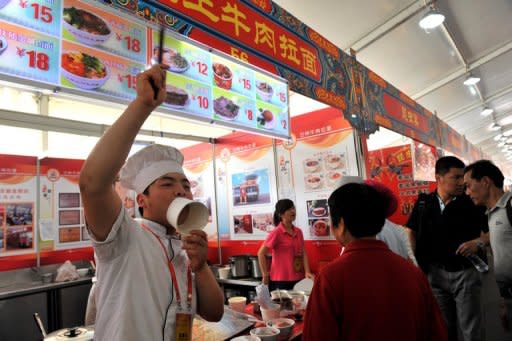China industrial output grows disappointing 9.6%
China's industrial output grew at a slower-than-expected 9.6 percent year-on-year in May, a faster clip than the previous month but still near three-year-lows, according to the government. While production from the country's millions of factories and workshops was stronger than the 9.3 percent expansion seen in April, it was still lower than forecasts of a 9.9 percent gain in a Dow Jones Newswires poll of 14 economists. "The turning point hasn't come yet. Economic growth is still declining," Citigroup economist Shuang Ding told Dow Jones Newswires. The disappointing figures came as Beijing seeks to boost economic growth to avoid a hard landing in the world's second largest economy, with other data showing falling infrastructure investment and a slowdown in consumer spending. However, inflation figures released earlier in the day showed growth in consumer prices eased to 3.0 percent in May, the lowest level since June 2010, giving the government further room to loosen credit to boost flagging growth. China has set itself a target of keeping annual inflation within four percent this year, fearing that surging prices carry the potential to cause social unrest as people grumble about paying more. But easing inflation should give the government more room to ease monetary policy to stimulate growth. China's economy grew 8.1 percent in the first quarter of 2012 year-on-year, its slowest pace in nearly three years. Hoping to spur growth, Beijing slashed interest rates by 25 basis points on Thursday -- its first cut in more than three years -- and moved to allow rates to float more freely. Analysts said the moves sent a strong message that China is willing to ease monetary policy to shore up expansion in the Asian powerhouse, which has played a key role in supporting the global economy in the current downturn. China has also cut bank reserve requirements three times since December as policymakers aim to boost lending to help growth. Alistair Thornton, Beijing-based China economist for IHS Global Insight, told AFP that further stimulus was likely in the coming months. "Growth in China is slowing rapidly, as price pressures continue to come off. That should act as a spur for government policy to combat the slowdown," he said. "We think it is very likely that there will be another interest cut through the rest of the year," while there was "clearly a lot more room" for cuts in bank reserve ratio requirements. Food prices were up 6.4 percent from a year earlier in May, compared with April's 7.0 percent rise, while non-food prices rose 1.4 percent from a year earlier, compared with April's 1.8 percent increase. The producer price index (PPI), which measures the cost of goods at the farm and factory gate and is an indicator of future consumer prices, slipped 1.4 percent in May year-on-year, a sharper fall than April's 0.7 percent slide. Meanwhile, the government said urban fixed asset investments rose 20.1 percent in the first five months of 2012 on-year, weakening from 20.2 percent in the first four months and 20.9 percent in the first three. Fixed asset investments in the cities are a key gauge of the Chinese government's infrastructure spending, which has increased rapidly in recent years as Beijing has sought to cushion the impact of the global downturn. And retail sales rose 13.8 percent in May compared with the same period a year earlier. They rose 14.1 percent in April on-year and 15.2 percent In March. Retail sales are the main gauge of consumer spending in the world's second-largest economy and serve as an indicator of the government's progress in making domestic consumption account for a bigger share of growth.




